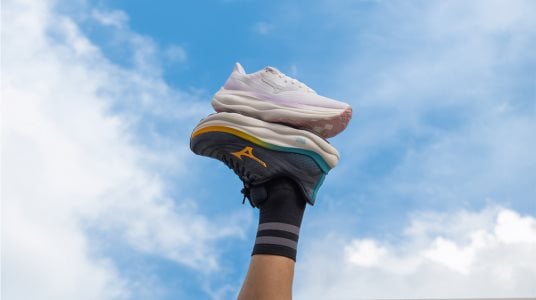Brooks Catamount 4 Review: Light, Fast and Ready to Climb

Catamount 4: Quick Facts
Weight:
- M: 269g US 9
- W: 232g US 8
Best For:
- Training and racing
- Mixed terrain
Price:
- $290 AUD
Stack Height, Drop & Lug Depth:
- 34mm heel / 28mm forefoot
- 6mm drop
- 3.5mm lugs
Favourite Features:
- SkyVault propulsive feel
- Nimble, closer to the ground ride
Release Date:
- January, 2025
What’s the Catamount 4 all about?
Brooks is kicking off the year strong in the trail department rolling out updates to the Caldera 8, Divide 5, and the Cascadia 19 to come later in the year. But today, we’re talking about the latest iteration of their speed-focused trail shoe: the Catamount 4.
Having been a fan of the Catamount 3, I often found myself reaching for it. In a market dominated by max-cushioned trail shoes, the Catamount 3 stood out as a low to the ground, nimble and stable option. While on the firmer side, it still provided enough protection and versatility to handle everything from speed sessions and hill reps to races and even some longer runs.
So, when I heard that Brooks was adding stack height to the Catamount 4, I was a little skeptical. It feels like every brand is upping stack heights year after year, sometimes unnecessarily. But after seeing the Catamount 4, I can confidently say that Brooks made thoughtful, well-executed updates based on athlete feedback.
It remains a lightweight, responsive shoe with great uphill propulsion while addressing some of the previous model’s shortcomings—most notably, cushioning for longer efforts and downhill comfort.

There's three key changes in Catamount 4:
1) More stack & comfort - but still speedy
The Catamount 4 introduces DNA Flash v2, alongside a 2mm increase in stack height. The result? A slightly softer, more compliant ride compared to its predecessor.
That said, don’t expect plush cushioning—the Catamount 4 still leans on the firmer side, maintaining the snappy, ground-connected feel that appealed to runners in previous versions. The extra stack height will add protection, making it more versatile for longer distances without sacrificing agility.

2) SkyVault v2, power up your climbs
One of the biggest structural changes is in the SkyVault plate. Previously full-length and positioned closer to the foot, it’s now a three quarter length plate that starts higher before tapering down towards the forefoot. You can even see it peeking through the outsole.
This tweak is meant to improve uphill propulsion and energy return, while also providing better underfoot feel when climbing. The previous Catamount really stood out for me on the climbs, it felt smooth efficient and made the effort feel easier. So if this new plate design improves that experience, I can't wait to try them out.

3) Sleeker upper and outsole tweaks
The upper has been refined by reducing overlays, which trims weight without compromising durability. The fit is secure yet accommodating and the toe bumper remains protective—ideal for technical terrain.
The heel counter is slightly shallow, similar to the version 3 which might be an issue for some, but I personally didn’t have lockdown issues and I would expect the same from this version (though I do use a heel lock lace for added security).
My one knock on the upper is the elastic loop to store laces in and prevent them getting caught on the trail is far down the eyelet chain. It's a small thing, but the laces are not long enough to reach it.
The outsole pattern has been tweaked for improved grip on both ascents and descents, and it retains the same 3.5mm lug depth. The TrailTack Green rubber performs well across a variety of surfaces, though it’s not the stickiest compound in wet conditions. It’s grippy enough for dry, rocky and packed dirt trails, but not a go-to for deep mud or soft terrain.

Our first thoughts
The Catamount 4 is built for speed, proving that you don’t need a heavily cushioned shoe to hit the trails and it's great to see brands putting effort into developing shoes in this category.
It excels on singletracks, climbs and mixed technical terrain, where its responsiveness and lightweight design shine. The SkyVault plate makes uphill running more efficient, while the improved cushioning allows for a bit more versatility in distance events.
For most runners, the Catamount 4 is best suited as a short-distance speed shoe for fast training sessions, races and technical runs. However, if you prefer lower-stack shoes and don’t mind a firmer ride, it can absolutely handle longer races. Personally, I see myself using it primarily for workout sessions—speed training, hill reps, and technical drills—as well as racing distances from 20 to 50km.
About the author
Seb Lopez - Trail Runner & Photographer
I’m passionate about trail running, hiking, adventure racing, and the outdoors in general. My favourite runs are long days spent with mates, exploring new places.
I also appreciate how different shoes allow me to connect with the terrain in unique ways and how that affects the running experience. When I’m not out on the trails, you’ll probably find me behind the camera as a sports photographer. It’s great to be on the other side and see the sport from a different angle.


